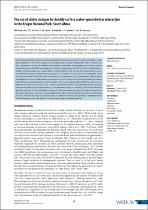| dc.contributor.author | Petersen, Robin | |
| dc.contributor.author | Nel, Jaco | |
| dc.contributor.author | Strydom, T | |
| dc.date.accessioned | 2023-07-04T08:26:27Z | |
| dc.date.available | 2023-07-04T08:26:27Z | |
| dc.date.issued | 2023 | |
| dc.identifier.citation | Petersen, R. et al. (2023). The use of stable isotopes to identify surface water–groundwater interaction in the Kruger National Park, South Africa. Water SA, 49(2), 96-102. 10.17159/wsa/2023.v49.i2.3992 | en_US |
| dc.identifier.issn | 0378-4738 | |
| dc.identifier.uri | 10.17159/wsa/2023.v49.i2.3992 | |
| dc.identifier.uri | http://hdl.handle.net/10566/9189 | |
| dc.description.abstract | The role of groundwater, in general, is often overlooked in freshwater ecosystem management policies and in the management of South Africa’s flagship conservation area, the Kruger National Park (KNP). To address this gap, a generalised conceptual model of surface water–ground water (sw–gw) interactions in the southern and central regions of the KNP was developed. To do this, stable isotope ratios (δ18O and δ2H) of groundwater, rainfall and surface water were used to determine the extent to which the base flow of perennial, seasonal and ephemeral streams on different geologies (granite vs. basalt) is driven by rainfall or groundwater. | en_US |
| dc.language.iso | en | en_US |
| dc.publisher | South African Water Research Commission | en_US |
| dc.subject | Groundwater quality | en_US |
| dc.subject | Sustainable Development Goals | en_US |
| dc.subject | Isotopes | en_US |
| dc.subject | Conservation | en_US |
| dc.subject | South Africa | en_US |
| dc.title | The use of stable isotopes to identify surface water–groundwater interaction in the Kruger National Park, South Africa | en_US |
| dc.type | Article | en_US |

